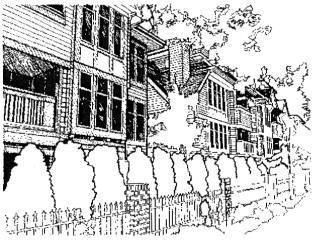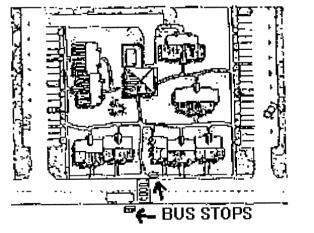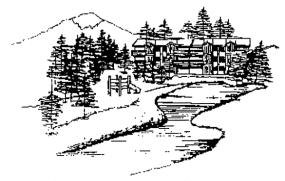Chapter 17.470
MULTIFAMILY DEVELOPMENT – DESIGN CRITERIA
Sections:
17.470.010 Purposes and intent.
17.470.020 Applicability – How to use the design criteria.
17.470.030 Multifamily site design – Orientation (UCR, UM and UH zones).
17.470.050 Recreation centers, mailboxes, site lighting, bus stops.
17.470.060 Grading and tree/vegetation retention.
17.470.010 Purposes and intent.
The general purposes of these design criteria are as follows:
A. To encourage better design and site planning.
B. To ensure that new multifamily development is sensitive to the character of the surrounding neighborhoods.
C. To enhance the built environment for pedestrians in higher-density areas.
D. To provide for development of neighborhoods with attractive, well-connected streets, sidewalks, and trails that enable convenient, direct access to neighborhood centers, parks, and transit stops.
E. To ensure adequate light, air, and readily accessible open space for multifamily development in order to maintain public health, safety and welfare.
F. To ensure the compatibility of dissimilar adjoining land uses.
G. To maintain or improve the character, appearance, and livability of established neighborhoods by protecting them from incompatible uses, excessive noise, illumination, loss of privacy, and similar significant impacts.
H. To encourage creativity and flexibility in the design of multifamily developments in a manner that maximizes unique site attributes and is compatible with the character and intensity of adjoining land uses.
(Ord. 534 (2016) § 7(5) (App. E) (part), 2016)
17.470.020 Applicability – How to use the design criteria.
A. Applicability.
1. The “requirements sections” in the following design criteria apply to each multifamily project requiring conditional use review under Chapter 17.540 or 17.550.
2. In addition to the requirements set forth in this chapter, the “requirements sections” set forth in Sections 17.480.160 and 17.480.180 to 17.480.240 shall apply to each multifamily project requiring review under subsection (A) of this section.
B. How to Use the Design Criteria. The “requirements sections” state the design criteria that each project shall meet. These design criteria are intended to supplement the development standards of the UCR, UM and UH zones. Where the provisions of this chapter conflict with the provisions of Chapters 17.210 (UCR), 17.220 (UM), and 17.230 (UH), the provisions of the zoning district shall apply. The “guidelines” which follow each requirement statement are suggested ways to achieve the design intent. Each guideline is meant to indicate the preferred conditions, but other equal or better design solutions will be considered acceptable by the director or hearing examiner, so long as these solutions meet the intent of these sections. They are to be applied with an attitude of flexibility, recognizing that each development site and project will have particular characteristics that may suggest that some guidelines be emphasized and others de-emphasized. However, while alternative solutions can be proposed, none of the criteria in the requirement statements can be disregarded.
(Ord. 534 (2016) § 7(5) (App. E) (part), 2016)
17.470.030 Multifamily site design – Orientation (UCR, UM and UH zones).
A. Requirement. Design multifamily projects to be oriented to public streets or common open spaces and to provide pedestrian and vehicular connections to existing neighborhoods.
B. Guidelines. Possible ways to achieve neighborhood connections include:
1. Use a modified street grid system where most buildings in a project front on a street. Where no public streets exist, create a modified grid street system within the project.
2. Locate parking areas behind or under building and access such parking from alley-type driveways. If driveway access from streets is necessary, minimum width driveway providing adequate firefighting access should be used.
3. Provide each building with direct pedestrian access from the main street fronting the building and from the back where the parking is located.
4. Another alternative may be to orient the buildings into U-shaped courtyards where the front door/main entry into the building is from a front courtyard. Access to the courtyard from the rear parking area should be through a well-lighted breezeway or stairway. This alternative will work where projects abut an arterial or major collector street where the quality of living could be enhanced with building facing into the courtyard. The buildings would still be located between the street and parking lot.
5. The following illustrations depict site-planning techniques that orient multifamily projects to streets, adding value and identity to the complex, by siting parking behind the buildings:

Examples of preferred site planning that orients multifamily projects to streets, adding value and identity to the complex, by siting parking behind the buildings.
(Ord. 534 (2016) § 7(5) (App. E) (part), 2016)
17.470.040 Fences and walls.
A. Requirement. Design the site to minimize the need for fences and walls that inhibit or discourage pedestrian use of sidewalks or paths, isolate neighborhoods, or separate neighborhoods from main roads.
B. Guidelines.
1. Place pedestrian breaks and/or crossing at frequent intervals where a fence, wall or landscaped area separates a sidewalk from a building or one development from another.
2. Employ small setbacks, indentations, stepped fence heights, or other means of breaking up the wall or fence surface and height.

Alternative to solid or blank-looking fence.
3. Employ different textures, color or materials (including landscape materials) to break up the wall’s surface and add visual interest.
4. If fencing is required, repeat the use of building facade materials on fence columns and/or stringers.
(Ord. 534 (2016) § 7(5) (App. E) (part), 2016)
17.470.050 Recreation centers, mailboxes, site lighting, bus stops.
A. Requirement. Provide adequate lighting, screening and pedestrian access to supporting facilities such as recreation centers, mailboxes, play yards, bus stops and dumpsters. If otherwise required as a condition of project approval, locate passenger shelters in well-lit areas with access to the multifamily walkway network. Provide for shielding and directing of light to minimize impacts upon residents and abutting property owners.
B. Guidelines.
1. Recreation Centers.
a. Recreation centers should have adequate parking and bike racks for the guests of tenants.
b. The center should be directly connected by a series of walkways to all the multifamily buildings in the complex. These walkways should be barrier free, landscaped, and lighted with fixtures not to exceed fifteen feet in height. The walkways should provide visual contrast where they cross driveways or streets.
2. Site Lighting.
a. Site lighting (pedestrian-scale and low level) should be provided throughout the project.
b. Security lighting should be provided in parking areas and play areas.
c. Lighting should not shine into the dwelling units in the development.
d. Lighting should be directed away from neighboring development.
3. Mailboxes. If common mailboxes are used, they should be located near the project entry or near the recreational facilities. The architectural character should be similar in form, materials, and colors to the surrounding buildings. Mailboxes should be well lighted and pedestrian accessible.
4. Bus Stops. The multifamily walkway network shall provide convenient pedestrian access to the nearest transit stop.

(Ord. 534 (2016) § 7(5) (App. E) (part), 2016)
17.470.060 Grading and tree/vegetation retention.
A. Requirement. To the extent reasonable and practicable, multifamily projects shall be designed to minimize impacts to existing topography and vegetation.
B. Guidelines.
1. Incorporate the natural grades in the overall design of the project.
2. Incorporate existing groups of trees/vegetation to be protected and retained on the site.
3. Minimize disturbance of open space to better facilitate storm water infiltration.
4. Stepping the building down a hillside to match the topography can reduce the impact of the building on smaller, nearby buildings.

(Ord. 534 (2016) § 7(5) (App. E) (part), 2016)
17.470.070 Open space.
A. Requirement. Open space shall be provided in or adjacent to multifamily development for all the residents of the development.
B. Guidelines.
1. Where possible, combine the open space of contiguous properties to provide for larger viable open space areas.
2. Site permanent outdoor recreation equipment away from storm drainage facilities.
3. Use walkways to connect the open spaces to the multifamily buildings, parking areas, and adjacent neighborhoods.
4. Incorporate a variety of activities for all age groups in the active recreational open space.
5. Consider drainage/retention areas that enhance the environment and open space usage.

(Ord. 534 (2016) § 7(5) (App. E) (part), 2016)
17.470.080 Landscape design.
A. Requirement. In addition to the requirements in Chapter 17.500, landscaping and supporting elements (such as trellises, planters, site furniture or similar features) shall be appropriately incorporated into the project design.
B. Guidelines.
1. Minimize tree removal and incorporate larger caliper trees to obtain the immediate impact of more mature trees when the project is completed.
2. Provide frameworks such as trellises or arbors for plants to grow on.
3. Incorporate planter guards or low planter walls as part of the architecture.
4. Landscape the open areas created by building modulation.
5. Incorporate upper story planter boxes or roof plants.
6. Retain natural greenbelt vegetation that contributes to greenbelt preservation.
7. On streets with uniform planting of street trees and/or distinctive species, plant street trees that match the street tree spacing and/or species.
8. Use plants that require low amounts of water, including native drought-resistant species, and require low amounts of chemicals and fertilizers.
9. Incorporate vegetation-based LID BMPs.
(Ord. 540 (2016) § 41, 2016: Ord. 534 (2016) § 7(5) (App. E) (part), 2016)


